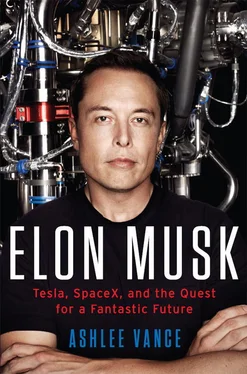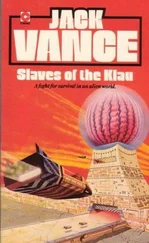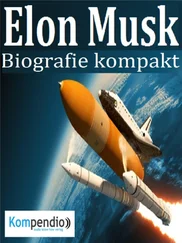By rights, Musk should have been part of the malaise. He jumped right into dot-com mania in 1995, when, fresh out of college, he founded a company called Zip2—a primitive Google Maps meets Yelp. That first venture ended up a big, quick hit. Compaq bought Zip2 in 1999 for $307 million. Musk made $22 million from the deal and poured almost all of it into his next venture, a start-up that would morph into PayPal. As the largest shareholder in PayPal, Musk became fantastically well-to-do when eBay acquired the company for $1.5 billion in 2002.
Instead of hanging around Silicon Valley and falling into the same funk as his peers, however, Musk decamped to Los Angeles. The conventional wisdom of the time said to take a deep breath and wait for the next big thing to arrive in due course. Musk rejected that logic by throwing $100 million into SpaceX, $70 million into Tesla, and $10 million into SolarCity. Short of building an actual money-crushing machine, Musk could not have picked a faster way to destroy his fortune. He became a one-man, ultra-risk-taking venture capital shop and doubled down on making super-complex physical goods in two of the most expensive places in the world, Los Angeles and Silicon Valley. Whenever possible, Musk’s companies would make things from scratch and try to rethink much that the aerospace, automotive, and solar industries had accepted as convention.
With SpaceX, Musk is battling the giants of the U.S. military-industrial complex, including Lockheed Martin and Boeing. He’s also battling nations—most notably Russia and China. SpaceX has made a name for itself as the low-cost supplier in the industry. But that, in and of itself, is not really good enough to win. The space business requires dealing with a mess of politics, back-scratching, and protectionism that undermines the fundamentals of capitalism. Steve Jobs faced similar forces when he went up against the recording industry to bring the iPod and iTunes to market. The crotchety Luddites in the music industry were a pleasure to deal with compared to Musk’s foes who build weapons and countries for a living. SpaceX has been testing reusable rockets that can carry payloads to space and land back on Earth, on their launchpads, with precision. If the company can perfect this technology, it will deal a devastating blow to all of its competitors and almost assuredly push some mainstays of the rocket industry out of business while establishing the United States as the world leader for taking cargo and humans to space. It’s a threat that Musk figures has earned him plenty of fierce enemies. “The list of people that would not mind if I was gone is growing,” Musk said. “My family fears that the Russians will assassinate me.”
With Tesla Motors, Musk has tried to revamp the way cars are manufactured and sold, while building out a worldwide fuel distribution network at the same time. Instead of hybrids, which in Musk lingo are suboptimal compromises, Tesla strives to make all-electric cars that people lust after and that push the limits of technology. Tesla does not sell these cars through dealers; it sells them on the Web and in Apple-like galleries located in high-end shopping centers. Tesla also does not anticipate making lots of money from servicing its vehicles, since electric cars do not require the oil changes and other maintenance procedures of traditional cars. The direct sales model embraced by Tesla stands as a major affront to car dealers used to haggling with their customers and making their profits from exorbitant maintenance fees. Tesla’s recharging stations now run alongside many of the major highways in the United States, Europe, and Asia and can add hundreds of miles of oomph back to a car in about twenty minutes. These so-called supercharging stations are solar-powered, and Tesla owners pay nothing to refuel. While much of America’s infrastructure decays, Musk is building a futuristic end-to-end transportation system that would allow the United States to leapfrog the rest of the world. Musk’s vision, and, of late, execution seem to combine the best of Henry Ford and John D. Rockefeller.
With SolarCity, Musk has funded the largest installer and financer of solar panels for consumers and businesses. Musk helped come up with the idea for SolarCity and serves as its chairman, while his cousins Lyndon and Peter Rive run the company. SolarCity has managed to undercut dozens of utilities and become a large utility in its own right. During a time in which clean-tech businesses have gone bankrupt with alarming regularity, Musk has built two of the most successful clean-tech companies in the world. The Musk Co. empire of factories, tens of thousands of workers, and industrial might has incumbents on the run and has turned Musk into one of the richest men in the world, with a net worth around $10 billion.
The visit to Musk Land started to make a few things clear about how Musk had pulled all this off. While the “putting man on Mars” talk can strike some people as loopy, it gave Musk a unique rallying cry for his companies. It’s the sweeping goal that forms a unifying principle over everything he does. Employees at all three companies are well aware of this and well aware that they’re trying to achieve the impossible day in and day out. When Musk sets unrealistic goals, verbally abuses employees, and works them to the bone, it’s understood to be—on some level—part of the Mars agenda. Some employees love him for this. Others loathe him but remain oddly loyal out of respect for his drive and mission. What Musk has developed that so many of the entrepreneurs in Silicon Valley lack is a meaningful worldview. He’s the possessed genius on the grandest quest anyone has ever concocted. He’s less a CEO chasing riches than a general marshaling troops to secure victory. Where Mark Zuckerberg wants to help you share baby photos, Musk wants to … well … save the human race from self-imposed or accidental annihilation.
The life that Musk has created to manage all of these endeavors is preposterous. A typical week starts at his mansion in Bel Air. On Monday, he works the entire day at SpaceX. On Tuesday, he begins at SpaceX, then hops onto his jet and flies to Silicon Valley. He spends a couple of days working at Tesla, which has its offices in Palo Alto and factory in Fremont. Musk does not own a home in Northern California and ends up staying at the luxe Rosewood hotel or at friends’ houses. To arrange the stays with friends, Musk’s assistant will send an e-mail asking, “Room for one?” and if the friend says, “Yes,” Musk turns up at the door late at night. Most often he stays in a guest room, but he’s also been known to crash on the couch after winding down with some video games. Then it’s back to Los Angeles and SpaceX on Thursday. He shares custody of his five young boys—twins and triplets—with his ex-wife, Justine, and has them four days a week. Each year, Musk tabulates the amount of flight time he endures per week to help him get a sense of just how out of hand things are getting. Asked how he survives this schedule, Musk said, “I had a tough childhood, so maybe that was helpful.”
During one visit to Musk Land, he had to squeeze our interview in before heading off for a camping trip at Crater Lake National Park in Oregon. It was almost 8 P.M. on a Friday, so Musk would soon be piling his boys and nannies into his private jet and then meeting drivers who would take him to his friends at the campsite; the friends would then help the Musk clan unpack and complete their pitch-black arrival. There would be a bit of hiking over the weekend. Then the relaxation would end. Musk would fly with the boys back to Los Angeles on Sunday afternoon. Then, he would take off on his own that evening for New York. Sleep. Hit the morning talk shows on Monday. Meetings. E-mail. Sleep. Fly back to Los Angeles Tuesday morning. Work at SpaceX. Fly to San Jose Tuesday afternoon to visit the Tesla Motors factory. Fly to Washington, D.C., that night and see President Obama. Fly back to Los Angeles Wednesday night. Spend a couple of days working at SpaceX. Then go to a weekend conference held by Google’s chairman, Eric Schmidt, in Yellowstone. At this time, Musk had just split from his second wife, the actress Talulah Riley, and was trying to calculate if he could mix a personal life into all of this. “I think the time allocated to the businesses and the kids is going fine,” Musk said. “I would like to allocate more time to dating, though. I need to find a girlfriend. That’s why I need to carve out just a little more time. I think maybe even another five to ten—how much time does a woman want a week? Maybe ten hours? That’s kind of the minimum? I don’t know.”
Читать дальше
Конец ознакомительного отрывка
Купить книгу










